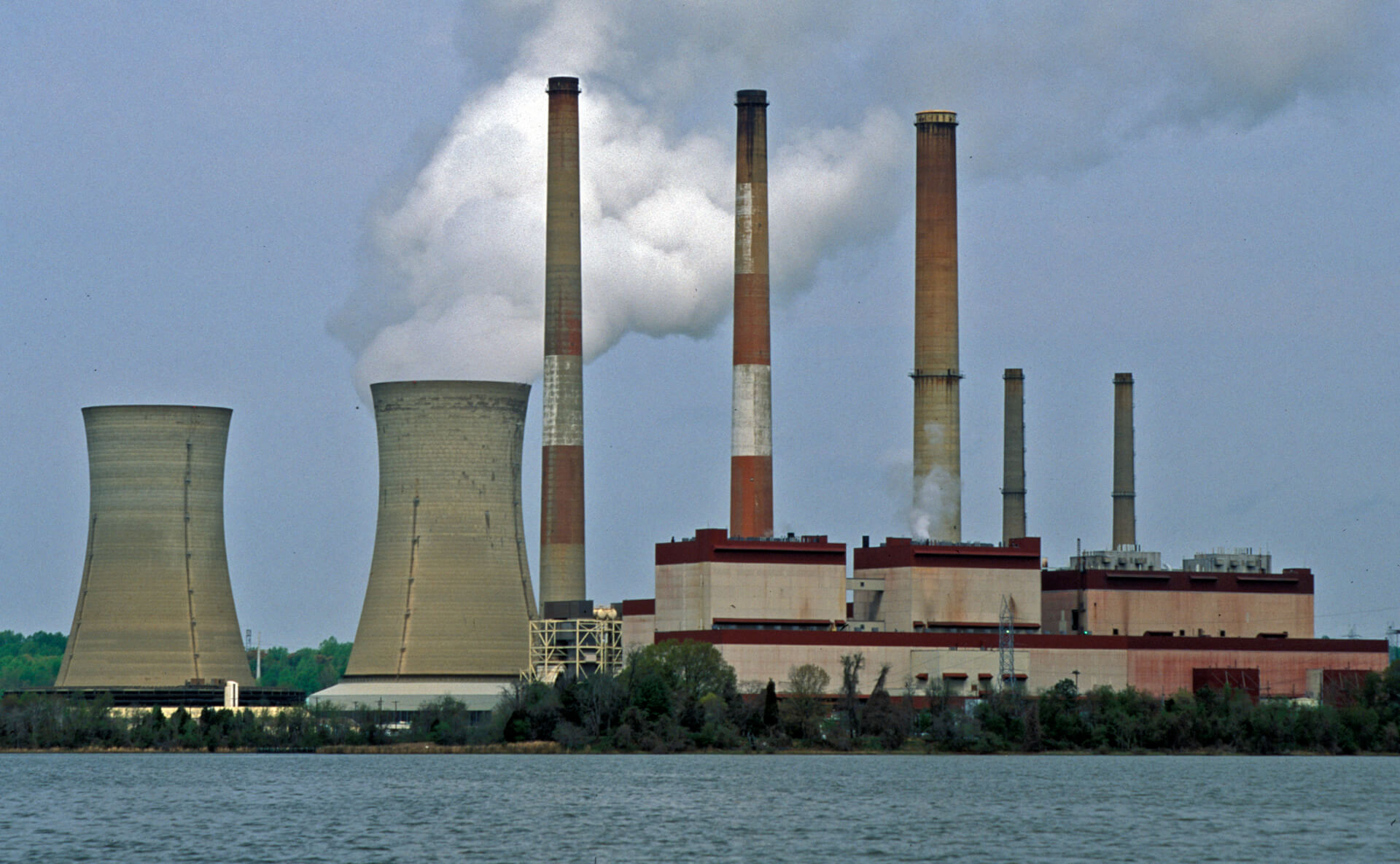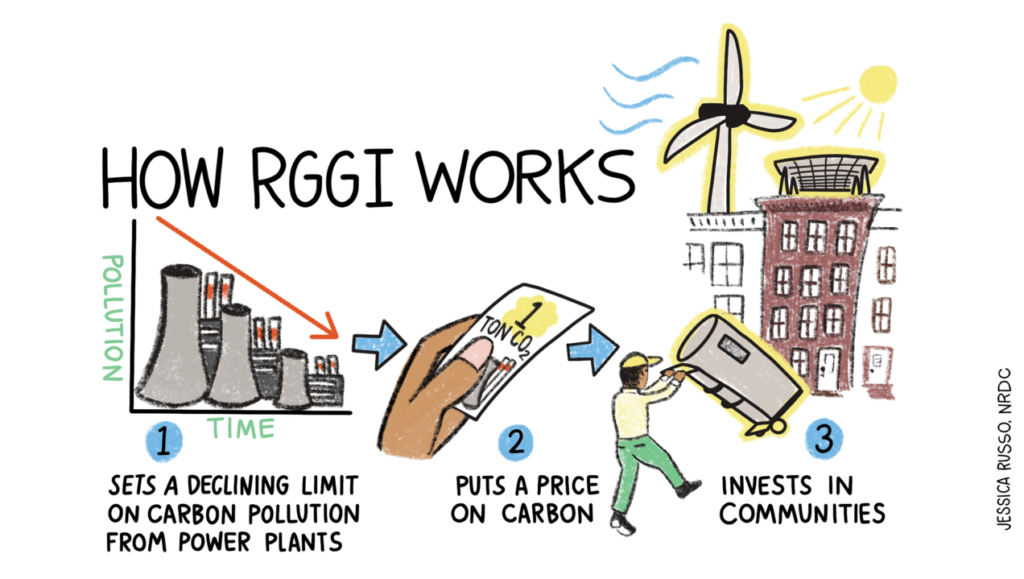A model program for fighting climate change is at a crossroads in Md. and neighboring states

Sometimes, states fight climate change in dramatic and tangible ways, with gigantic solar arrays, wind turbines, abundant electric vehicle charging stations, or highly visible coastal resiliency projects.
Other times, the battle is more prosaic and bureaucratic and harder to see.
Four times a year, in a small room near Wall Street, Maryland and many of its neighboring states wage a quiet but durable war against pollution from coal-fired electric plants.
The office in New York is headquarters of RGGI Inc., a nonprofit consortium of a dozen Northeastern and Mid-Atlantic states. Commonly referred to as “Reggie,” RGGI stands for the Regional Greenhouse Gas Initiative.
Once every three months, RGGI auctions off pollution credits for electric plants powered by fossil fuels. This cap-and-trade system — some people prefer the term “cap-and-invest” — is designed to not only reduce carbon emissions throughout the region, but to make the polluters pay. The quarterly auctions have been compared to trading in a commodities market.
That description alone would make almost anyone’s eyes glaze over. But this fact should make them pop wide open again: Over the course of 57 auctions dating back to 2009, Maryland alone has taken in $970 million, which it has used to fund an array of clean energy projects and energy assistance payment programs for low-income residents.
On its website, the Maryland Department of the Environment refers to RGGI as “a central component of Maryland’s greenhouse gas strategy.”
“RGGI has emerged as the premier example of how multiple states can work together on a climate and energy policy and expand it over time,” said Barry Rabe, a professor of public policy at the University of Michigan, who studies government climate action.
By almost any measure, RGGI is one of the most successful programs in the world to fight climate change. And since a Supreme Court ruling this summer limited the U.S. Environmental Protection Agency’s ability to regulate power plant emissions, the importance of RGGI has been magnified.
“There’s nothing in that opinion the prevents the states from moving ahead with greenhouse gas regulation, including cap-and-trade,” said Ben Grumbles, the former Maryland Environment secretary who recently became executive director of the Environmental Council of the States, the umbrella organization for state environmental regulators. “Increasingly, the Supreme Court is paving the way for states to do more. If the political will is there, states can make real progress.”
Despite RGGI’s importance, it operates in relative obscurity, trapped in the jargon and arcana of trading markets and science.
“RGGI,” Grumbles said, “is one of the best-kept secrets that delivers results for the nation on a bipartisan basis.”
How it works
Together, the participating states have established a regional cap on CO2 emissions, and limited the emissions that come from power plants in the RGGI states. The regional cap declines over time, ensuring that CO2 emissions decrease on a predictable schedule. Since the program’s inception, emissions have reduced in RGGI states by more than 50% — twice as fast as the nation as a whole — and raised billions of dollars for the participating states.

Graphic courtesy of Jessica Russo/NRDC.
“It’s safe to say that RGGI has had some role in the significant decarbonization of Northeastern states,” Rabe said.
What appeals to many elected officials — especially Republican leaders in the RGGI states, including Maryland Gov. Larry Hogan — is that the program is market-based. Regulated power plants must buy one RGGI CO2 allowance for every short ton of carbon they emit. The RGGI states distribute the allowances at the quarterly auctions, where they can be purchased by power plants and other entities, including investors.
“It’s a ton of money,” said Kim Coble, executive director of the Maryland League of Conservation Voters and co-chair of the state government’s Commission on Climate Change. “A ton of money.”
The next quarterly auction is scheduled for Dec. 7. The last one, in September, generated $301 million for the RGGI states.
“Assuming market trends continue, we could top $1 billion in proceeds in December, just for our state,” said Joey Tsu-Yi Chen, senior adviser to the chair of the Maryland Public Service Commission. “That’s amazing.”
But celebrated as RGGI is among scientists, government officials, and climate activists, both for its environmental impacts and all the revenue it has generated for the participating states, the program is at something of a crossroads. Part of that is internal: Every few years RGGI goes through an intensive internal program review, with all the stakeholders weighing in and proposing changes to the way the initiative works.
RGGI is also buffeted by the external politics and policy debates in each of the states that belong to the consortium. As Northeastern and Mid-Atlantic states — including Maryland — in general craft more aggressive goals for combating climate change, the question becomes whether the program can adapt and meet the urgency of a rapidly warming planet.
“Some states are wondering whether RGGI’s goals are keeping up with theirs,” said Karen Palmer, a senior fellow at Resources for the Future, a national nonprofit that conducts research into environmental, energy, and natural resource policies and how they impact the economy and social programs.
State Sen. Paul Pinsky (D-Prince George’s), chair of the Senate Education, Health and Environmental Affairs Committee and chief sponsor of the Climate Solutions Now Act, which set dramatically more aggressive emissions reductions goals for Maryland, views RGGI as something of an anachronism — nice to have and useful in its way, but not impactful enough.
“It’s worked some,” Pinsky said. “It’s obviously brought us revenue to bring clean energy money coming in. And it’s good that we’re making coal plants pay for polluting.”
But Pinsky said the state needs to set its sights on investor-owned electric and gas utilities, which continue to resist tougher clean building standards and other attempts to reduce the use of fossil fuels.
“Look, RGGI serves a purpose,” he said. “But we have some tough decisions to make about reducing carbon dioxide emissions. Utilities are going to claw and fight to the very end.”
Even with its challenges and criticisms, RGGI is often held up as a model for how other climate fighting-programs ought to work. While the European Union has a fairly successful carbon trading program, other states and regions in North America have attempted to replicate the RGGI model, usually with limited success. Other attempts have been abject failures.
But RGGI “is the engine that has kept going and expanded,” said Rabe, the University of Michigan professor.
Evolution
At a time when many Republican elected officials are seen as impediments to efforts to combat climate change, it’s almost hard to fathom that RGGI was, to a great extent, the brainchild of a former Republican governor of New York, George Pataki, who helped build support for the concept from surrounding states beginning in 2005. Maryland came on board in 2007, and the first auction for carbon credits took place in 2009, with 10 states participating.
Even as the program thrived and stabilized, the trajectory hasn’t been entirely linear, and, with a lot of procedural caveats, states can essentially come and go as they please. New Jersey, an early entrant in RGGI, pulled out of the program in 2012 when Republican Chris Christie was governor. It rejoined in 2020 under Democratic Gov. Phil Murphy.
For years, Maryland was the southernmost state in the consortium, until Virginia joined a few years ago under former Gov. Ralph Northam (D). But now, Northam’s successor, Republican Glenn Youngkin, wants to pull the state out, arguing that the program has led to higher utility costs for ratepayers and questioning whether RGGI was actually reducing carbon emissions. In fact, RGGI has cost containment provisions to ensure that power companies don’t charge exorbitant rates to their customers to comply with the environmental goals of the program.
Nevertheless, the Youngkin administration has tried repeatedly to remove Virginia from RGGI, through executive order, legislation and budget amendments — but so far has not succeeded. Most recently, Youngkin has asked the State Air Pollution Control Board to develop an emergency regulation to remove Virginia from RGGI — a move that will almost certainly result in lawsuits.
In North Carolina, Democratic Gov. Roy Cooper has taken steps to bring the state into RGGI, but that will be a slow and politically charged process. The Republicans who dominate in the state legislature are already determined to fight the idea.
Perhaps most significantly, Pennsylvania has just joined, and by its sheer size and the number of power plants there that run on fossil fuels, will have a major impact on the scale of the program overall. Gov. Tom Wolf (D) took the final procedural steps for the state to enter the program in April, but they have since been tied up in litigation, and Democratic Gov.-elect Josh Shapiro has been skeptical of the program in the past.
Since formally entering the program, Pennsylvania has missed out on three auctions so far, aggravating climate activists and Democratic policymakers.
“It’s frustrating to see deadline after deadline go by,” Molly Parzen, executive director for Conservation Voters of Pennsylvania, told the Pennsylvania Capital-Star recently.
The battles over RGGI in each of the participating states “make for quite a political story,” said Rabe, the University of Michigan professor.
Boosting clean energy and helping low-income Marylanders
For Maryland, participation in RGGI has been both an economic boon and environmentally advantageous. In addition to the $970 million that RGGI has brought in over the past 13 years, the program accounts for a significant reduction of carbon emissions, according to state estimates. Using a formula set up by U.S. EPA to gauge the social cost of carbon, the Maryland Department of the Environment estimated in 2020 that RGGI would account for a reduction of 3.60 million metric tons of carbon dioxide equivalents a year, enough to save the state $176 million in health care and environmental impact costs.
Every state in RGGI gets to determine how it will participate in the program and how the proceeds from the auctions can be used. In Maryland, three agencies have a role, and they largely follow guidelines and policy goals set by the General Assembly.
In every RGGI state, the state government’s environmental protection agency and its utility regulator are participants in the governance of the initiative, with seats on the RGGI executive board. So in Maryland’s case, that means the Maryland Department of the Environment and the Public Service Commission are involved (Grumbles, when he was the state’s environment secretary, served as board chair for two years). In addition, the revenues from the quarterly RGGI auctions are distributed by the Maryland Energy Administration, so that means a third state agency is involved.
RGGI proceeds are distributed through the state’s Strategic Energy Investment Fund (SEIF), which MEA administers. The fund has a board of advisers that consists of state officials, utility ratepayers and industry representatives. In fiscal year 2021, the fund distributed more than $60 million.
MEA has used the funding to hand out grants for myriad clean energy projects across the state, including energy and water infrastructure projects, microgram development, and energy studies. But there is also a requirement from the legislature to spend 60% of the funds in low-income communities. That means everything from installing solar panels on the rooftops of Baltimore City row houses to funding assistance programs for residents struggling with their home heating bills. The state also requires 20% of the funds to be used for energy efficiency measures.
A study on SEIF funds for FY 21 showed that 52% of the proceeds went to energy bill assistance programs in Maryland, whereas for the RGGI states overall just 15% of the funding went to bill assistance. In Maryland, 20.5% of the funds went to energy efficiency programs, compared to 54% of funding going to energy efficiency in all the RGGI states collectively.
That ratio is sure to be debated by Maryland policymakers and other stakeholders in the future.
Every year, the state makes projections to calculate how much revenue to expect from RGGI auction sales, which becomes part of the budget process.
“In our opinion, it’s been very successful,” said Chris Hoagland, director of Air and Radiation at the Maryland Department of the Environment, who manages the agency’s climate program. “It was designed in a very transparent way and operates in a very transparent way. That really amplifies the benefits of the program.”
But as the state begins to implement the sweeping Climate Solutions Now law, which was passed through the General Assembly earlier this year, the question becomes whether RGGI, for all its demonstrable value, can be updated in a way to more easily help the state meet its new aggressive emissions reduction goals. Similar conversations are taking place in the other RGGI states, and there is some imbalance, said Palmer of Resources for the Future, because some states have more aggressive emissions reduction goals than their neighbors.
Even if the RGGI states share a goal of dramatic decarbonization, coming to consensus “is going to take some creative thinking,” she said.
Environmental leaders from RGGI states have already committed to improving the way the program addresses environmental justice challenges. But the details have yet to be worked out, and those conversations will be part of the overall program review that is expected to be completed in the latter part of 2023.
Maryland officials have already begun planning and preparing for the program review, the third in RGGI’s history. It’s almost a circular process: State officials come to their RGGI counterparts with a priority list; the RGGI board then crafts policy goals and an action plan; the states themselves then modify how they implement the changes through rulemakings and legislation.
“The ultimate goal is a consensus among the states,” said Hoagland.
Chen, of the Public Service Commission, said he is crunching numbers in advance of conversations with state agency chiefs and their counterparts from other states.
“We get into the weeds and we present recommendations to the decision-makers,” he said. “Right now, we are in an analysis modeling phase for the program.”
Can the model work elsewhere?
RGGI first started operating at a time when the concept of cap-and-trade was fairly new and gaining traction. The U.S. House passed a bill in 2009 to launch a national cap-and-trade system, and prominent Republican U.S. senators like John McCain and Lindsey Graham expressed interest in the concept — though the House bill eventually ran aground in the Senate, and the climate bill was partially responsible for a Republican wave election in 2010.
Even so, RGGI’s cap-and-trade system was held up as a possible model for other states and regions. And yet, it has never widely taken hold. California has launched its own cap-and-trade system for power plant emissions and envisioned teaming with other states in its region. So far, its only trading partner is Quebec, on the other side of the continent — though Washington state may become a part of that consortium soon. Washington and Oregon recently set up cap-and-trade programs of their own.
And an effort to launch a RGGI-like system with several Midwestern states collapsed several years ago before it ever got off the ground, even though half a dozen states committed to participating and others were involved in the discussions.
More recently, an effort by 13 Northeastern and Mid-Atlantic states to set up a cap-and-trade system to tackle carbon emissions in the transportation sector has stalled.
Maryland officials were part of the early conversations about the Transportation and Climate Initiative, a project of the Georgetown Climate Center at Georgetown University that would have set up a RGGI-like structure. But in the end, only Massachusetts, Connecticut, Rhode Island and the District of Columbia decided to join formally. In the fall of 2020, Hogan refused to sign the memorandum of understanding officially entering the state into the consortium. Six other states followed suit — and the plan, for now, is dormant.
“That ran into a lot of headwinds for a whole lot of reasons,” Grumbles said. “Multiple states weren’t ready for it.”
With gasoline prices continuing to surge, state leaders are unlikely for the foreseeable future to want to embrace a carbon reduction strategy that opponents may label as a gas tax hike.
“I’m hoping that gets resurrected,” said the Maryland League of Conservation Voters’ Coble.
Grumbles predicted that a day might come when a cap-and-trade program to reduce emissions in the building sector also gets discussed. But that is probably a long way off.
Rabe, of the University of Michigan, suggested that states might also want to eventually come together to discuss a scheme to reduce emissions from hydrofluorocarbons, the industrial chemicals primarily used for cooling and refrigeration.
RGGI is the model for interstate cooperation on any number of potential emissions reduction measures. But can it ever be duplicated? With federal attempts to offer sweeping climate protections stymied by the courts or political opposition, it may be the best — or maybe even the only — way to proceed, Rabe said.
“We don’t have a lot of models in climate policy in the United States that have been so durable and can be modified,” he said.





 Creative Commons Attribution
Creative Commons Attribution